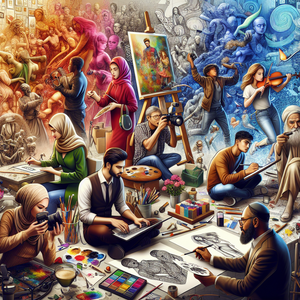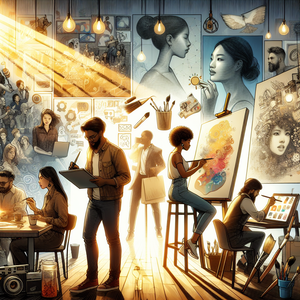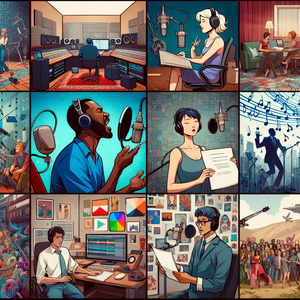
Unleashing Your Creative Potential: 15 Exciting Art Careers to Consider in 2024
As we embark on the journey of 2024, the art and design industry is thriving, offering a wealth of opportunities for creative minds. The recent conversations surrounding art careers highlight a vibrant landscape filled with traditional roles, such as fine artists and illustrators, alongside innovative fields like digital design and animation. This dynamic sector is not only growing but is also set to expand in tandem with the economy, enabling aspiring artists to forge fulfilling careers while expressing their unique creativity.
Job Summaries:
Animator:
- Animators harness digital technology to breathe life into characters and narratives.
- Creating visual effects for films, video games, and advertisements.
- Mastery of software like Adobe After Effects and Maya is crucial.
- A portfolio that showcases storytelling and character design prowess is important.
- With the increasing demand for animated content, this career promises excitement and significant growth opportunities.
Graphic Designer:
- Graphic designers are the visual communicators of the digital age.
- They craft compelling content that conveys messages effectively across print and digital media.
- Utilizing design tools such as Adobe Illustrator and Photoshop.
- They create logos, brochures, and advertisements.
- A bachelor’s degree in graphic design or a related field is often required.
- A portfolio that highlights creativity and technical skill is essential.
- As businesses increasingly recognize the importance of powerful visual communication, graphic designers play an essential role in shaping brand identities.
Art Director:
- Art directors oversee the visual direction of creative projects.
- They lead teams of designers and illustrators to achieve cohesive and compelling designs.
- They are instrumental in defining the artistic style for various media, including advertisements, magazines, and websites.
- They collaborate closely with clients.
- This leadership position typically requires a bachelor’s degree in fine arts or design.
- It requires extensive industry experience and a strong portfolio.
Illustrator:
- Illustrators craft images that convey ideas and narratives.
- Frequently working on children’s books, magazines, and advertisements.
- They employ a blend of traditional and digital techniques to produce artwork that captures the essence of stories.
- While a degree in illustration or fine arts can be advantageous, a diverse portfolio showcasing various styles is vital for attracting clients and opportunities.
Fashion Designer:
- Fashion designers combine aesthetics with practicality to create clothing and accessories.
- Their process involves trend research, sketching designs, selecting fabrics, and overseeing production, often working closely with manufacturers.
- A bachelor’s degree in fashion design is typically necessary, alongside strong skills in sewing and pattern-making.
- As sustainability becomes increasingly important, innovative designers who embrace new materials are in high demand.
Web Designer:
- Web designers enhance the look and functionality of websites.
- They blend creativity with technical expertise to build engaging user interfaces.
- Proficiency in design software and coding languages like HTML and CSS is essential.
- A background in graphic design or web development is common.
- A portfolio of successful web projects is crucial.
- The ever-expanding digital landscape ensures that skilled web designers remain highly sought after.
Curator:
- Curators manage collections in museums and galleries.
- Responsible for acquiring new pieces.
- Organizing exhibitions.
- Conducting research.
- A master’s degree in art history or museum studies is often required.
- Strong organizational skills are necessary.
- Curators play a vital role in preserving cultural heritage.
- Educating the public about art is part of their work.
- Their work is immensely impactful.
Art Teacher:
- Art teachers inspire the next generation by educating students in various artistic disciplines.
- They design lesson plans, teach techniques, and provide constructive feedback on student progress.
- This role typically requires a bachelor’s degree in art education or fine arts, along with teaching certification.
- Art teachers are key in fostering creativity and artistic talent among young learners.
UX/UI Designer:
- UX/UI designers focus on optimizing user experiences for digital products.
- Ensuring that websites and applications are intuitive and user-friendly.
- They conduct user research, create wireframes, and design layouts that enhance interaction.
- A background in design, psychology, or human-computer interaction is beneficial.
- A strong portfolio of successful projects is important.
- The demand for UX/UI designers continues to rise as digital experiences become integral to our daily lives.
Interior Designer:
- Interior designers craft functional and aesthetically pleasing spaces for homes and businesses.
- They assess client needs, develop design concepts, select furnishings, and oversee installations.
- A bachelor’s degree in interior design is typically required, as well as relevant certifications.
- Their expertise transforms living and working environments, enhancing overall quality of life.
Video Game Designer:
- Video game designers create concepts and develop visual and gameplay elements for games.
- They collaborate with artists, programmers, and writers to produce engaging experiences.
- A degree in game design or computer science is often required.
- A portfolio that showcases both creativity and technical skills is necessary.
- The gaming industry is experiencing explosive growth.
- Opportunities for video game designers abound.
Art Therapist:
- Art therapists use creative processes to help individuals express emotions and overcome psychological challenges.
- They work in various settings, employing art as a therapeutic tool.
- Typically, a master’s degree in art therapy or psychology, along with certification, is necessary.
- Art therapists play a crucial role in promoting emotional well-being and facilitating healing through creativity.
Fine Artist:
- Fine artists create original works using diverse media such as painting and sculpture.
- While formal education is not strictly required, a degree in fine arts can enhance credibility.
- A strong portfolio is essential for attracting buyers or galleries.
- Fine artists contribute to cultural conversations with their unique perspectives and creativity.
Photographer:
- Photographers capture images that tell stories or evoke emotions across various fields.
- They employ technical skills and creativity to produce high-quality images, often using editing software like Adobe Lightroom.
- While some photographers hold degrees in photography, a versatile portfolio is crucial for success in this competitive field.
- Photographers play a significant role in visual storytelling within both the art world and media.
Set Designer:
- Set designers create physical environments for film, theater, and television.
- They work closely with directors, designing and constructing sets that enhance storytelling.
- A background in theater design, architecture, or fine arts is beneficial, along with strong drafting and model-making skills.
- As the entertainment industry continues to expand, the demand for creative set designers is on the rise.
As you navigate these exciting career paths in art and design, consider how each aligns with your creative aspirations and current industry trends. Take the time to explore job openings in these fields to propel your artistic journey forward!
Explore More Jobs

